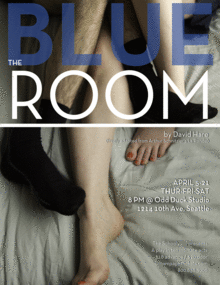 When The Blue Room first opened on Broadway in 1998 Ben Brantley of the New York Times called it the “play that New Yorkers would seemingly sacrifice their firstborn to get into.” Was David Hare’s script that good? Was it the promise of a series of staged liaisons that attracted so much attention? Surely it wasn’t the chance to see Nicole Kidman partly nude!
When The Blue Room first opened on Broadway in 1998 Ben Brantley of the New York Times called it the “play that New Yorkers would seemingly sacrifice their firstborn to get into.” Was David Hare’s script that good? Was it the promise of a series of staged liaisons that attracted so much attention? Surely it wasn’t the chance to see Nicole Kidman partly nude!
The Schoolyard’s production of David Hare’s adaptation of Arthur Schnitzler’s 1897 play Reigen, (better known as La Ronde) has no such celebrity draw. However Mariel Neto and Andrew Murray do a fine job in a variety of roles. They play a cycle of scenes in which a couple comes together and has sex (in a timed blackout) and then each resolves to their post-coital lives. One character from each scene appears in the next scene creating a round of infidelities.
A hot evening of sensual entertainment this is not. These feel less like acts of passion than determination. Part of this is a lack of chemistry between the actors and part of this is the script. The characters are mostly unpleasant, and their attitudes are archaic. The men tend to be unreconstructed and immature with the frail naiveté and idealism of a fin de siècle inamorato (see any prose play by Ibsen). The women feel drawn less from life than from the imagination of these men.
Though each character has a different status in the first act they all seem like the same two people wearing different hats. This might have been interesting if played out by different actors. Using the same two actors in each scene already suggests that the characters share some quality or are, in fact, one. The multiplicity of casting, which David Hare wrote into the script, comes off as overkill. Only the prostitute and the Mrs. Robinson character stand out as the power dynamic in those couplings is more equitable.
Things turn around after intermission as Hare and Schnitzler leave the archetypes that set the wheel spinning for characters they know: theatre people. A playwright, a diva, and her aristocratic admirer bring us back toward a full circle. These characters, especially Murray’s roles, become reflective, philosophical, even didactic enough to directly address the audience—while remaining vapid and self-important. Happiness remains almost absurd but hope comes to seem almost possible.
Neto does a fine job in her roles. She is as believable playing a middle-aged married woman as she is playing a young au pair. Her drug-addled 17-year-old is a touch strained, but that may just be her pigtails. Murray is a pleasant actor but his baby face doesn’t read as anything but 23. His adjustments from one character to the next are cosmetic and he has yet to develop an instinct for responding when things go awry. Luckily Neto is there to smooth things over, as she did on Friday night with Murray’s misbehaving suspenders.
Costumes are a little spotty. The most notable slip is the confusion over the English playwright’s reference to a jumper (i.e. sweater) and skirt, which appears as a short one-piece dress. Sets are excessive, indistinct and cluttered. Set changes take place in unbearably long blackouts, and it isn’t clear whether the inconsistent lighting is a choice or a technical difficulty. If a choice then it works well in the opening scene of prostitute solicitation as Neto slips in and out of shadow.
Schoolyard has some good actors doing fine work. If they will remember that the audience’s attention is a precious commodity that must be conserved and retained for the entirety of a given performance they may achieve great things.